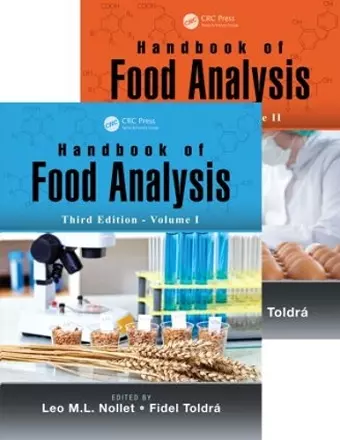Handbook of Food Analysis - Two Volume Set
Leo ML Nollet editor Fidel Toldra editor
Format:Set / collection
Publisher:Taylor & Francis Inc
Published:10th Jun '15
Currently unavailable, and unfortunately no date known when it will be back

Updated to reflect changes in the industry during the last ten years, The Handbook of Food Analysis, Third Edition covers the new analysis systems, optimization of existing techniques, and automation and miniaturization methods. Under the editorial guidance of food science pioneer Leo M.L. Nollet and new editor Fidel Toldra, the chapters take an in-depth look at how to determine the chemical composition of foodstuffs at the level required to safeguard consumer health, well-being, and safety.
See What’s New in the Third Edition:
- Discussions of analysis techniques of rheological, thermal, and flavor properties of food
- Examination of methods and techniques in food analysis
- Coverage amines, flavorings, and food traceability
Unparalleled in breadth and depth, the set delineates the physical and chemical properties of nutrients and other food components. It presents an exhaustive compilation of analytical methods and provides step-by-step descriptions of preparation, detection, separation, derivatization, and clean-up techniques. It also assesses the relative advantage, accuracy, and reliability of each procedure.
Volume 1 covers Physical and Sensory Properties; Additives, Adulteration, and Traceability; and Nutritional Analysis while Volume 2 covers Residues and Other Food Components; as well as Methods, Techniques, and Instruments. Together the two volumes examine both parts of food analysis: analytical and quantitative testing of product composition and guaranteeing product quality and safety as productivity increases. These volumes give you the analytical foundation required to develop food products free from contaminants and toxins and the tools to control their safety.
"The introduction to the third edition indicates that this handbook has been totally reinvented since it was last reviewed (CH, Feb'05, 42-3149). This time, Nollet (emer., Univ. College Ghent, Belgium) and coeditor Toldrá (Instituto de Agroquímica y Tecnología de Alimentos, Spain)—who also contributed to the second edition—have reduced the number of volumes from three to two and divided each volume into sections. The chapters have been completely rearranged, and many new authors were chosen to write the essays. The first volume contains the following sections: "Physical and Sensory Properties," "Additives, Adulteration, and Traceability," and "Nutritional Analysis." Volume 2 treats in 21 chapters various residues and other food components, and another fifteen chapters detail methods, techniques, and instruments. Some of the essays are titled the same as previously (e.g., the chapters on peptides, amino acids, and organic bases), but most of them are unique to this edition. As before, there is a table of contents, a list of contributors, and an extensive list of references. Each essay offers charts, tables, and formulas to better illustrate the topic. This highly scientific source is aimed at those advanced students and researchers studying food analysis. For libraries maintaining extensive chemistry collections that already have the second edition, it is probably worth obtaining the new edition because of the extensive revision of knowledge over the past decade and the editors' inclusion of wholly new topics. Summing up: Recommended. Upper-level undergraduates through researchers/faculty."
—S. A. Marien, American University, Washington, District of Columbia, USA, for CHOICE, March 2016
ISBN: 9781466556546
Dimensions: unknown
Weight: 3070g
1568 pages
3rd edition